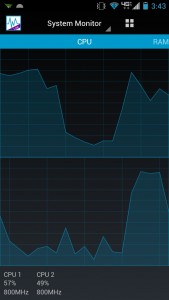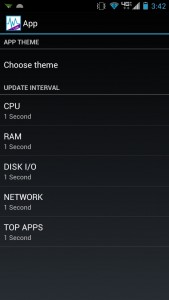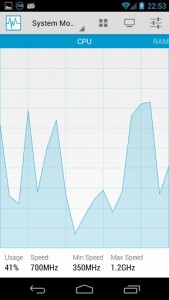 There are plenty of monitoring apps for Android, that’s for sure. A few of them offer comprehensive tool sets, and a plethora of functions to help you keep your device running at top notch. System Monitor is a resource monitoring app, packed with five different monitoring tools to help you figure out what your device is up to behind the scenes.
There are plenty of monitoring apps for Android, that’s for sure. A few of them offer comprehensive tool sets, and a plethora of functions to help you keep your device running at top notch. System Monitor is a resource monitoring app, packed with five different monitoring tools to help you figure out what your device is up to behind the scenes.
What is it and what does it do
Main Functionality
System Monitor is a charming and comprehensive resource monitor for Android smartphones and tablets. It allows you to monitor the CPU load, RAM usage, I/O statistics, network usage, and your most used applications. There are free (lite) and pro versions available, but for the purpose of this report we used the lite version.
- Accurate resource monitors of varying types
- CPU monitor, including individual core usage
- RAM monitor
- Disk I/O monitor
- Network monitor
- Application monitor (running services)
- Is able to identify the CPU/RAM used by individual apps
- Multiple visual themes for added customization
- Option to assign update intervals for each resource monitor tool (1-1000 seconds)
- No advertisements
- Would be nice to see a more detailed breakdown of Disk I/O and Network stats
- Pro version ($1.99) includes functionality the lite version does not
- Android notifications support
- Overlay pop-up window
- Widgets support
- DeskClock third party support
- Just displays information, cannot take action from directly within the app
- Uses a significant amount of RAM while running, 62MB total on the test device
Discussion
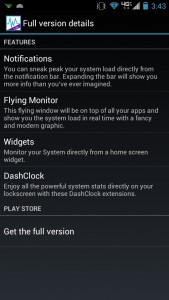 The first thing I’ll talk about is the difference between the pro version and the lite version. In terms of system monitoring, both versions are the same- there are no limitations on the monitoring functions in the lite version. However, the pro version includes several convenience features that add to the functionality of the app. For example, in the pro version you can take advantage of a resource display in the Android notifications bar, an overlay monitoring window that appears on top of other apps, compatible widgets, and DashClock support (DashClock is a third party app). While it is unfortunate that these features are not offered in the lite version, the pro version is only $1.99.
The first thing I’ll talk about is the difference between the pro version and the lite version. In terms of system monitoring, both versions are the same- there are no limitations on the monitoring functions in the lite version. However, the pro version includes several convenience features that add to the functionality of the app. For example, in the pro version you can take advantage of a resource display in the Android notifications bar, an overlay monitoring window that appears on top of other apps, compatible widgets, and DashClock support (DashClock is a third party app). While it is unfortunate that these features are not offered in the lite version, the pro version is only $1.99.
In the lite version, you can still customize the theme of the app and the update interval of each resource monitor. The intervals are pre-defined and can occur within the range of 1 second all the way to 1000.
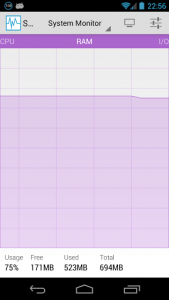 There are four different resource monitors, in addition to an application monitor. Keep in mind this program is designed to give you a reference as to what’s going on with your device. That means, you cannot stop apps or modify the system in any way, at least not within System Monitor.
There are four different resource monitors, in addition to an application monitor. Keep in mind this program is designed to give you a reference as to what’s going on with your device. That means, you cannot stop apps or modify the system in any way, at least not within System Monitor.
Each resource monitor tells you how much of a component is being used, unfortunately there are no detailed reports for the network monitor and disk I/O. The application monitor tells you which apps are using the most CPU power and RAM, and you can also rearrange them depending on usage amounts.
In the CPU resource monitor, you have the option to filter stats by the entire CPU, or individual cores if you have a multi-core device.
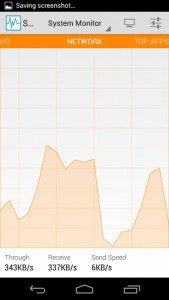 This app is ideal for those who are well versed in mobile tech. That does not mean the average Joe cannot make sense of the resource monitors because they’re actually pretty easy to read. It just means that more knowledgeable users will know what to do with the resulting information.
This app is ideal for those who are well versed in mobile tech. That does not mean the average Joe cannot make sense of the resource monitors because they’re actually pretty easy to read. It just means that more knowledgeable users will know what to do with the resulting information.
It would be nice to see more detailed reports for the network and I/O monitors that way you can take action if you find something wrong. For example, you can determine whether or not the device is using a network connection heavily, but you cannot see what apps or system tools are the culprit of such usage.
There are only a couple themes, including a light and dark one, but the user interface is quite attractive. It’s pretty easy to interpret the various monitors too, so you won’t have any trouble understanding what’s going on. With a resource monitor tool like this, that’s certainly valuable.
One serious issue with System Monitor is that it uses a lot of RAM while running. To be exact, it used 62MB during testing. If you just use the app to check on device stats, and then shut it down afterward this is not a huge problem. If you leave it running in the background however, it will probably cause some issues with decreased battery life and system resource availability.
Conclusion and download link
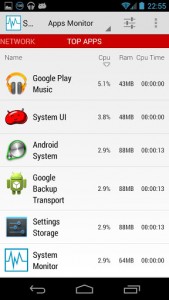 System Monitor is an excellent application to check out what’s happening on your device. It allows you to easily and accurately monitor various internal components like the CPU, RAM, and network usage. Best of all, the application monitor allows you to determine which apps are using RAM and CPU the most.
System Monitor is an excellent application to check out what’s happening on your device. It allows you to easily and accurately monitor various internal components like the CPU, RAM, and network usage. Best of all, the application monitor allows you to determine which apps are using RAM and CPU the most.
Overall, System Monitor is an excellent resource monitoring tool. If you know how to interpret the data and act accordingly, then System Monitor is perfect for you.
Price: Free, $1.99 (Pro version)
Version reviewed: 1.0.164
Requires: 4.0 and up
Download size: 985KB
System Monitor Lite on Play Store

 Email article
Email article
